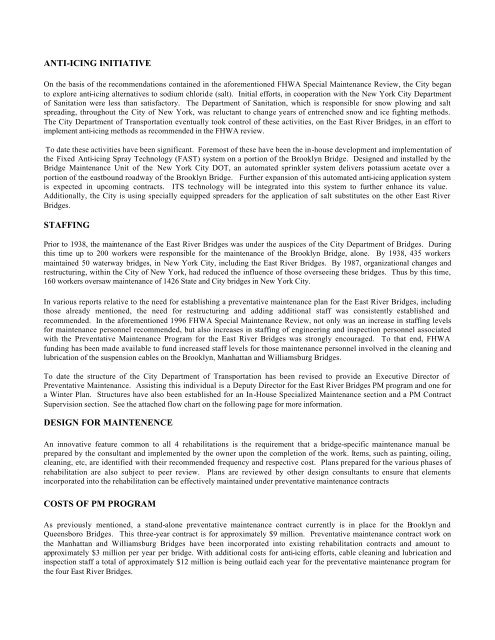MANAGING THE EAST RIVER BRIDGES IN NEW YORK CITY
MANAGING THE EAST RIVER BRIDGES IN NEW YORK CITY
MANAGING THE EAST RIVER BRIDGES IN NEW YORK CITY
You also want an ePaper? Increase the reach of your titles
YUMPU automatically turns print PDFs into web optimized ePapers that Google loves.
ANTI-IC<strong>IN</strong>G <strong>IN</strong>ITIATIVE<br />
On the basis of the recommendations contained in the aforementioned FHWA Special Maintenance Review, the City began<br />
to explore anti-icing alternatives to sodium chloride (salt). Initial efforts, in cooperation with the New York City Department<br />
of Sanitation were less than satisfactory. The Department of Sanitation, which is responsible for snow plowing and salt<br />
spreading, throughout the City of New York, was reluctant to change years of entrenched snow and ice fighting methods.<br />
The City Department of Transportation eventually took control of these activities, on the East River Bridges, in an effort to<br />
implement anti-icing methods as recommended in the FHWA review.<br />
To date these activities have been significant. Foremost of these have been the in-house development and implementation of<br />
the Fixed Anti-icing Spray Technology (FAST) system on a portion of the Brooklyn Bridge. Designed and installed by the<br />
Bridge Maintenance Unit of the New York City DOT, an automated sprinkler system delivers potassium acetate over a<br />
portion of the eastbound roadway of the Brooklyn Bridge. Further expansion of this automated anti-icing application system<br />
is expected in upcoming contracts. ITS technology will be integrated into this system to further enhance its value.<br />
Additionally, the City is using specially equipped spreaders for the application of salt substitutes on the other East River<br />
Bridges.<br />
STAFF<strong>IN</strong>G<br />
Prior to 1938, the maintenance of the East River Bridges was under the auspices of the City Department of Bridges. During<br />
this time up to 200 workers were responsible for the maintenance of the Brooklyn Bridge, alone. By 1938, 435 workers<br />
maintained 50 waterway bridges, in New York City, including the East River Bridges. By 1987, organizational changes and<br />
restructuring, within the City of New York, had reduced the influence of those overseeing these bridges. Thus by this time,<br />
160 workers oversaw maintenance of 1426 State and City bridges in New York City.<br />
In various reports relative to the need for establishing a preventative maintenance plan for the East River Bridges, including<br />
those already mentioned, the need for restructuring and adding additional staff was consistently established and<br />
recommended. In the aforementioned 1996 FHWA Special Maintenance Review, not only was an increase in staffing levels<br />
for maintenance personnel recommended, but also increases in staffing of engineering and inspection personnel associated<br />
with the Preventative Maintenance Program for the East River Bridges was strongly encouraged. To that end, FHWA<br />
funding has been made available to fund increased staff levels for those maintenance personnel involved in the cleaning and<br />
lubrication of the suspension cables on the Brooklyn, Manhattan and Williamsburg Bridges.<br />
To date the structure of the City Department of Transportation has been revised to provide an Executive Director of<br />
Preventative Maintenance. Assisting this individual is a Deputy Director for the East River Bridges PM program and one for<br />
a Winter Plan. Structures have also been established for an In-House Specialized Maintenance section and a PM Contract<br />
Supervision section. See the attached flow chart on the following page for more information.<br />
DESIGN FOR MA<strong>IN</strong>TENENCE<br />
An innovative feature common to all 4 rehabilitations is the requirement that a bridge-specific maintenance manual be<br />
prepared by the consultant and implemented by the owner upon the completion of the work. Items, such as painting, oiling,<br />
cleaning, etc, are identified with their recommended frequency and respective cost. Plans prepared for the various phases of<br />
rehabilitation are also subject to peer review. Plans are reviewed by other design consultants to ensure that elements<br />
incorporated into the rehabilitation can be effectively maintained under preventative maintenance contracts<br />
COSTS OF PM PROGRAM<br />
As previously mentioned, a stand-alone preventative maintenance contract currently is in place for the Brooklyn and<br />
Queensboro Bridges. This three-year contract is for approximately $9 million. Preventative maintenance contract work on<br />
the Manhattan and Williamsburg Bridges have been incorporated into existing rehabilitation contracts and amount to<br />
approximately $3 million per year per bridge. With additional costs for anti-icing efforts, cable cleaning and lubrication and<br />
inspection staff a total of approximately $12 million is being outlaid each year for the preventative maintenance program for<br />
the four East River Bridges.
















